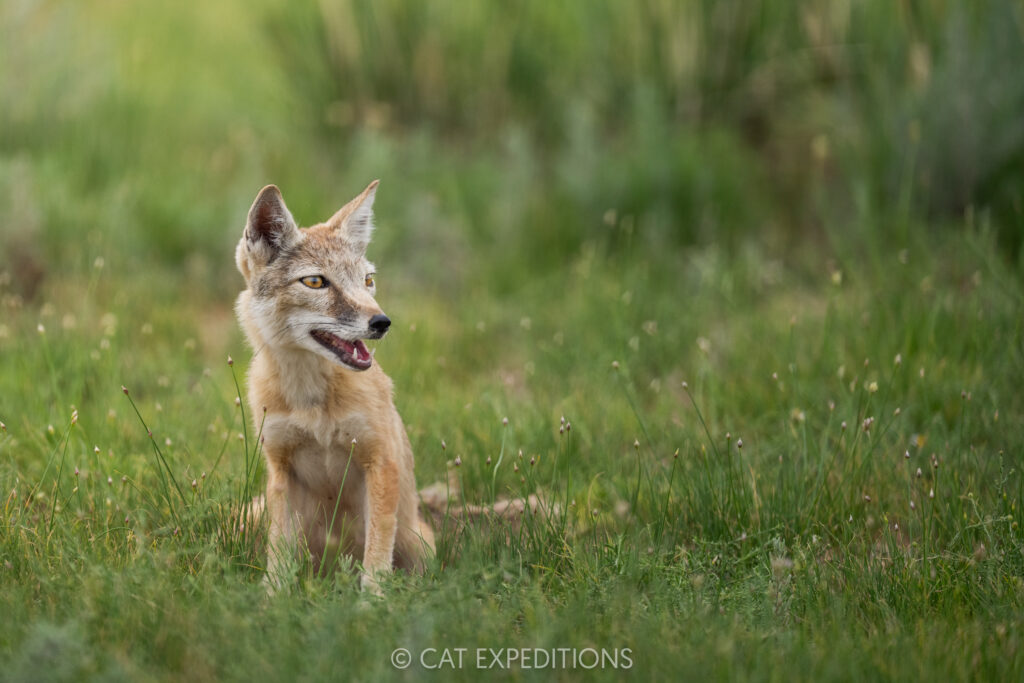This was the third of our three annual manul photo tours, where we photograph pallas’s cats in eastern Mongolia. We are highlighting the events of our third tour, spending time with two different Pallas’s cat families, including our favorite manul mother of the season, Nutella. Read the rest of our third manul of Mongolia photo tour 2025 trip report to hear about all the details.
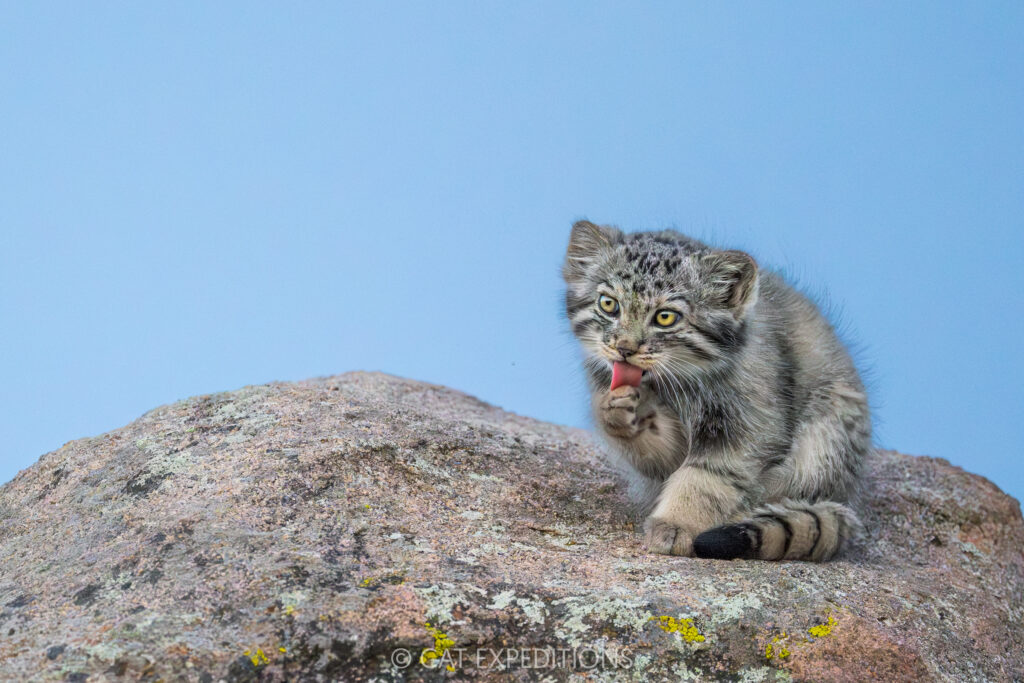
Highlights of the third 2025 Manul of Mongolia Photo Tour
Manul: We spent nearly all our time—ten out of eleven photo sessions—with one extraordinary manul family: mom Nutella and her three six-week-old kittens. We couldn’t have asked for a better subject. Our closest encounter was just six meters away, and on average, the cats were a comfortable twenty-one meters from our hides. Best of all, we had manul sightings every single day we were in the field.
Manul Den: All of our sessions with Nutella took place at a single den—a rare treat, especially since manuls often move dens frequently once the kittens get a little older. This stability gave us the chance to experiment with different blind placements, offering new angles, lighting, and compositions each time. One of the most memorable moments came during a glorious sunrise, when we photographed the cats in stunning backlight and silhouette against a glowing sky.
Manul Kittens Playing: Across the tour, we were lucky to witness more than ten hours of pure, unfiltered joy—manul kittens playing. That kind of extended observation gave everyone the opportunity to capture countless images of these fuzzy troublemakers as they pounced, tumbled, chased tails, and wrestled on the rocks. It was adorable, hilarious, and a true privilege to witness.
Detailed third Manul of Mongolia Trip Summary 2025
Day 1: Despite the hustle and bustle of the Naadam festival taking over Ulaanbaatar, everyone made it to the hotel right on time—honestly, that might have been the biggest miracle of the entire week! With all our guests arriving before dinner, we kicked off the trip with a welcome presentation right there at the restaurant, sharing good food and even better company.
One of our guests was a returning friend from our second trip, and she brought with her a week’s worth of incredible stories, excitement, and energy. While we, as trip leaders, tried to keep things grounded—sharing what to realistically expect in the days ahead—her enthusiasm quickly blew those cautious tones out of the water. Story after story spilled out: close encounters, magical moments, unforgettable sightings. It wasn’t long before the whole group was buzzing with anticipation.
It was the perfect start to the adventure—good food, great stories, and a group already feeling like a team before we’d even left the city.
Day 2: What a day of contrasts it was—one none of us will forget.
Expecting heavy traffic as we left Ulaanbaatar due to the Naadam festival, we had braced ourselves for a long, slow crawl out of the city. But to our surprise, the roads were nearly empty, and we cruised out toward the eastern steppes with barely a pause. After a warm, relaxed lunch halfway, we were feeling hopeful, excited, and fully switched into expedition mode.
That shifted in an instant.
A sudden, guttural scream from Minda, one of our trusted drivers, cut through the calm. It was the kind of sound you never forget—the kind that hits deep in your gut before your mind even understands what’s happening. We didn’t know the details at first, but we knew it was something awful. With help from our other driver, we soon learned the heartbreaking truth: Minda’s son had gone missing in a lake, 200 kilometers away. He had already been missing for hours.
We pulled over and dropped Minda off along the road where his wife was waiting. Her face—etched with horror, disbelief, and grief—will stay with us forever. There was nothing we could do, and yet every one of us wished we could shoulder even a fraction of their pain.
A somber stillness fell over the group as we continued to camp, now with Sebastian driving the second vehicle. We offered to help however we could upon arrival, but in reality, the most supportive thing we could do was to move forward quietly and respectfully, placing as little strain on the remaining team as possible. Both Minda and his brother—one of the key biologists—were now understandably gone.
That evening, despite the heaviness in our hearts, we made our way to Marmite’s new den site. We had met her on our second trip, and to our surprise, she had relocated about 500 meters away—a sign that her kittens were growing up, confident enough to trek the steppe by her side.
We hadn’t been in the blind long when Marmite appeared, her glowing yellow eyes peeking over the rocks like a fuzzy guardian spirit. She surveyed us, and the land around her, for over half an hour in golden light. Then, one by one, her kittens began to emerge. But something was different. Instead of their usual chaos and energy, they simply sat there, quiet and alert, their small bodies still, their eyes scanning the horizon alongside their mother. We couldn’t help but wonder what they were looking at—what they were sensing.
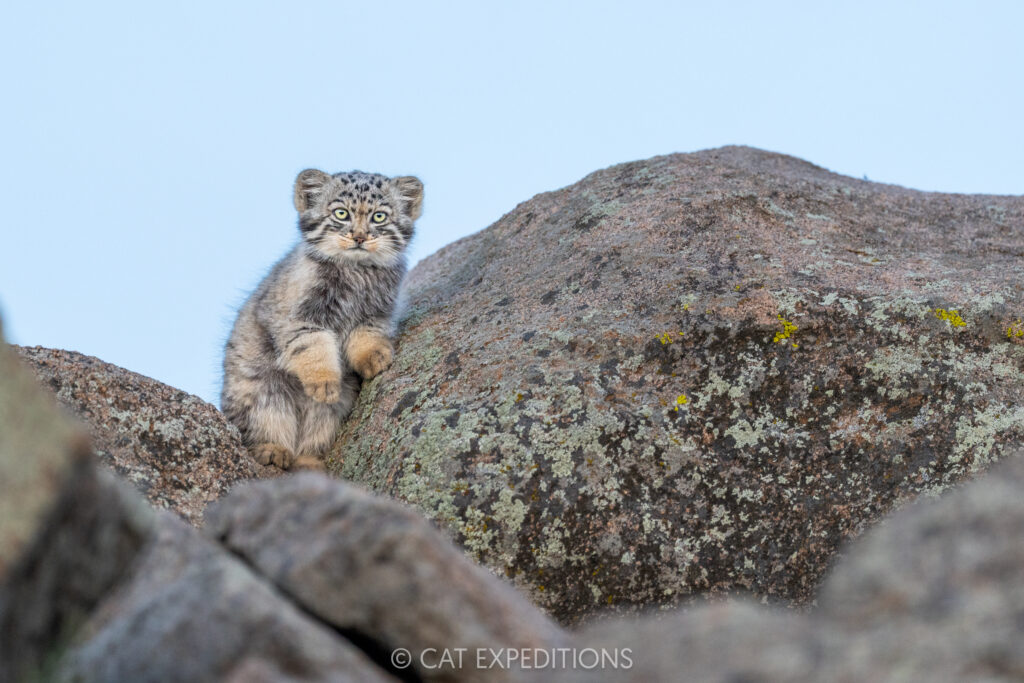
Ten minutes into this tense silence, a sharp cry of a Steppe Eagle pierced the air, and in a blink, all the kittens vanished into the safety of the den. A harsh reminder of the dangers that surround them. But eventually, the calm returned. One little head emerged, then another. A playful bat of the paw. A stretch. A yawn. Life resumed its rhythm.
As Marmite grew more relaxed, her kittens began exploring the nearby grasses, darting in and out like wind-blown wisps of fur. From time to time, a tail would poke up—a secret flag in a sea of green. Twice, a kitten launched vertically into the air, startled by who-knows-what. It was too quick for our shutters, but not for our hearts. We all laughed quietly, grateful for even these fleeting, blurry moments.
As the last light faded and the sky darkened, Marmite softly called her kittens. One by one, they trotted to her side, and she began leading them away through the tall grass. It was clear she was on the move again, and we gave her the space to disappear fully before being picked up ourselves and heading back to camp.

That night at dinner, our emotions were tangled—deeply moved by the experience at the den, and equally heavy with grief. We had just received confirmation that Minda’s son had died. A tragic accident. A family’s worst nightmare. We sat in quiet reflection, the weight of the day settling in. And even as we recalled the joy and awe from earlier, we couldn’t help but be reminded of what really matters.
That night, many of us sent messages home. Hugged each other tighter. Held a little more space for sorrow, and for gratitude. The wild has a way of teaching perspective—and this day, more than any other, reminded us of just how fragile, and beautiful, life is.
Day 3: It was time to ease back into our familiar rhythm—our trusty 4 a.m. departure to catch the soft light at the den. But nature had other plans. Despite our best efforts, we just couldn’t relocate Marmite. To make matters more complicated, a steady rain fell from the sky, making finder her all the more difficult.
After about an hour of searching through the mist and puddles, we made the call to shift gears. Rather than push through soggy terrain chasing shadows, we opted to stay dry and shift our focus to the steppe’s other wild residents—from the comfort of our vehicles.
And it turned out to be a great decision.
We soon found our familiar Eurasian Eagle-Owls, and this time, we got especially lucky. One of the chicks let us get incredibly close—just ten meters away—completely undisturbed. There’s something magical about locking eyes with such a powerful bird, especially at that range.
And then, as if the steppe was listening to us, we spotted a little owl perched atop a rocky pile—just minutes after remarking that we hadn’t seen one since our first trip here in 2021. These pint-sized owls, barely ten inches tall, are bundles of fluff and attitude. We spent five sweet minutes with it before it took off, attempting to snatch an insect mid-air (and missing, rather charmingly). That moment—seeing one of the largest owls and one of the smallest in the same morning—left us feeling like the steppe was sharing some of its quiet magic with us.

Soon after, the skies opened for real. Buckets of rain poured down, soaking the land and any chance of more field time that morning. But we returned to camp content, cozying up in the warmth of our gers, swapping photos and stories over lunch, and holding out hope that the skies might clear in time for an afternoon session.
As the rain kept tapping on our gers that afternoon, we found ourselves doing our own version of manul peek-a-boo—opening the ger door every few minutes, willing the storm clouds to pass and give us just a sliver of a dry window. Eventually, the rain lightened to a drizzle, and that was all the excuse we needed to give it a shot. We grabbed our gear and headed out to visit Nutella, the ever-reliable queen of this landscape, who we’ve had the joy of following since our very first manul tour this year.
And wow—she delivered.
Barely five minutes after we tucked into the blind, Nutella emerged, calm and collected, as if she’d been expecting us. Moments later, her six-week-old kittens came tumbling out behind her, completely bursting with energy. It was clear they’d been cooped up in the den all day, and the “zoomies” were in full swing.
Manul kitten play is a thing of chaotic beauty. It’s a blur of pouncing, hopping, and sideways sprints. Rocks become toys, grasses get ambushed, and tails—especially unsuspecting sibling tails—are the prized possession. The way they lower their bodies and wiggle their rumps before leaping at a bird (or a brother) is pure joy to watch.
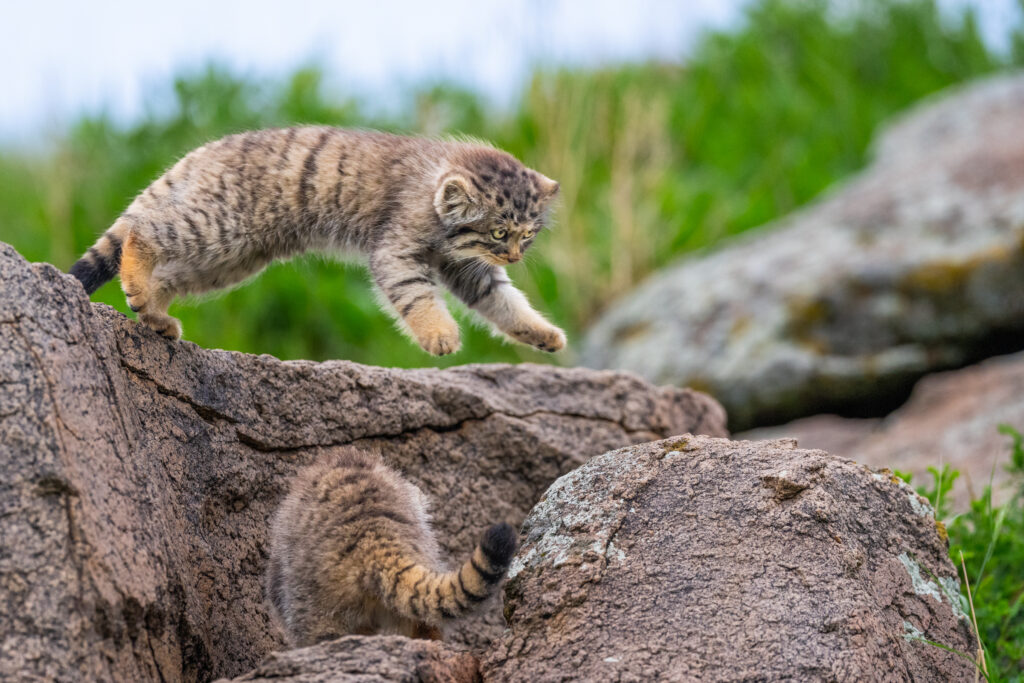
And every time we get to witness it, we’re floored by how special it is. Among the world’s small wild cats, this kind of repeated, close, natural observation—especially with a mother and her kittens—is nearly unheard of. Only here, with the manul of Mongolia, is something like this even possible. We know just how lucky we are, and not a moment goes by that we take it for granted.
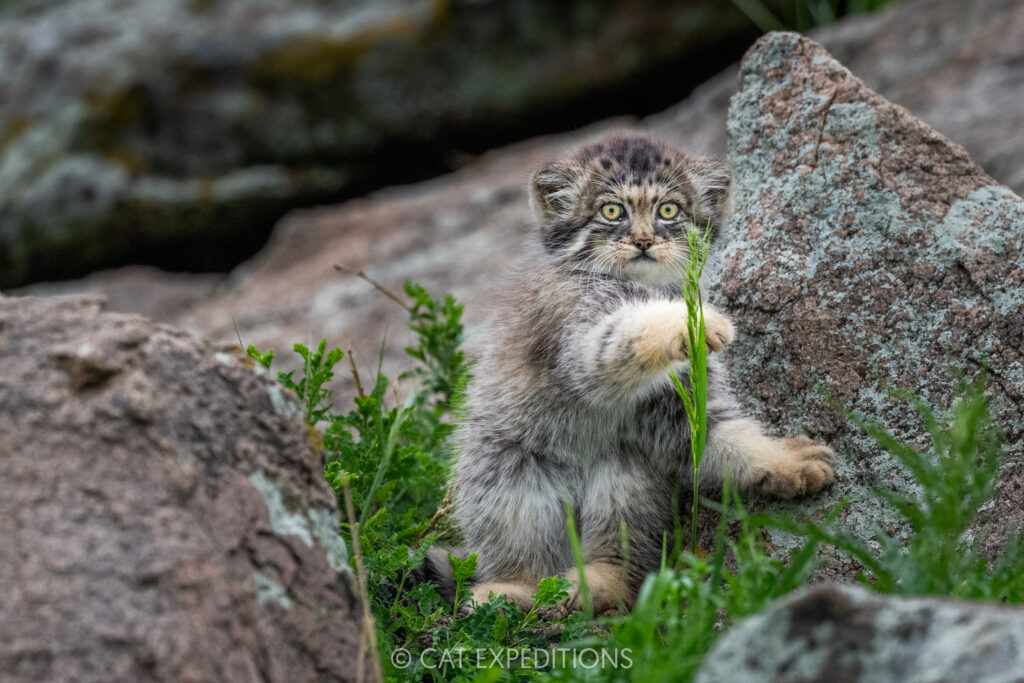
For two glorious hours, we watched the show. Then, as if someone flipped a switch, it all came to a stop. The kittens disappeared back into the den, Nutella settled into the rocks, and the rain returned, heavier this time. We packed up, a little soggy but completely content, and made our way back to camp with big smiles and bigger memories.
Day 4: We awoke to a sky blanketed in soft gray—overcast, but thankfully no rain in sight. The air felt calm, like the steppe was holding its breath, and we were eager to head back to Nutella and her little ones. To our relief, she hadn’t moved dens overnight. We were back at our usual 4 a.m. departure, and as the softest hints of morning light painted the landscape, we slipped into the blind.
What happened next felt like magic.
Barely a minute after we settled in, the first kitten peeked out. Then another. Then another. Normally we expect a long wait—an hour, sometimes more—but this morning, the kittens seemed just as eager as we were. Their energy was contagious. This particular den is roomy, with long rocky corridors and hidden nooks, and the kittens treated it like their own personal racetrack. They darted from one end to the other, pouncing, tumbling, chasing tails and shadows alike.
Nutella, as ever the attentive mother, disappeared occasionally on hunting forays. And she didn’t come back empty-pawed. Over the course of three hours, she returned three times—each time bringing a vole for her young. We never actually saw the moment of delivery, but we always knew she’d returned when the kittens’ growls erupted from the den. A little scrap would break out, and soon one proud kitten would appear, victorious, a vole dangling from its mouth.

Then came one of our favorite sights of all: Nutella climbed atop a rock and began to nurse. It’s such a vulnerable moment—a raw, maternal intimacy—and seeing her do this in the open, under our watchful lenses, was the clearest sign she was comfortable with us there. We always treat these moments with the reverence they deserve. They are not promised. They are gifts.
There was something special in the air that morning. Maybe it was the soft light, the calm after so much rain, or simply the joy of seeing this family thrive. Whatever it was, we soaked in every second—grateful, humbled, and buzzing with peaceful joy.
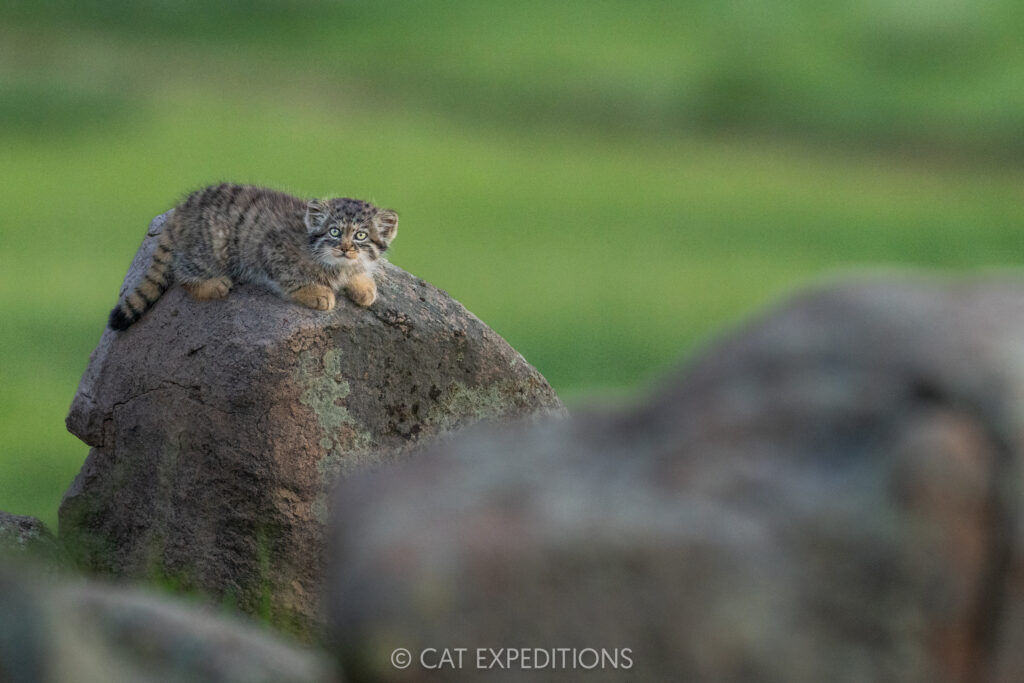
In the afternoon, we returned to Nutella, this time setting up the blind from a new angle—one that would give us a fresh perspective with beautiful soft greens as a backdrop… if the cats decided to show themselves. It was definitely more of a gamble. Most of the den was hidden from this vantage, and as the minutes turned to hours, we started to wonder: were they even home?
Normally, you catch a flicker of movement—an ear twitch, the flick of a tail—but this time, the rocks stood still, silent, and seemingly empty. The sun made its slow descent, transitioning from a fierce white orb to a golden disk, and then finally to a soft haze behind the clouds. Still, no sign of cats.
And then, just as we were beginning to resign ourselves to an action-less session, Nutella suddenly appeared—slipping through the landscape like a ghost. She’d returned from one of her hunting forays, moving gracefully behind boulders, making no sound. She settled on a lower rock formation, visible only to a few of us in the blind. These are the bittersweet moments in the field—thrilling because something is happening, but frustrating when not everyone gets a view.

Nutella began to nurse her kittens. For most of us, we could only see the top of her head, but the moment she flopped onto her back, completely at ease, we heard it—this quiet, collective “aww…” drifting through the blind. She was so at peace, so trusting, letting her kittens snuggle in, safe and warm.
By then, the light was gone. Cameras were mostly down. Few photos were taken. But it didn’t matter. That moment—fleeting and tender—was why we were here. These are the interactions that live deepest in our memory, far beyond any image we could ever take. A small slice of wild intimacy, shared with one of the most unique cats on earth. And we wouldn’t trade that for anything.
Day 5: Wildlife photography, for us, has always been rooted in natural history knowledge, deep patience, and—most of all—unwavering persistence. So, with that spirit guiding us, we returned to the blind at 4:20am, opting again for the slightly unconventional, but potentially golden, angle we’d tested the previous afternoon. Would the gamble pay off this time? We hoped so.
Sure enough, right on schedule, Nutella emerged—slipping out from behind one of the many rocks that make up her den. She always moves with this quiet sense of purpose, as if every step has been planned. We could tell right away she was heading out to hunt, crossing a small rise and disappearing from view. But knowing her, it wouldn’t be long before she returned, vole in mouth.
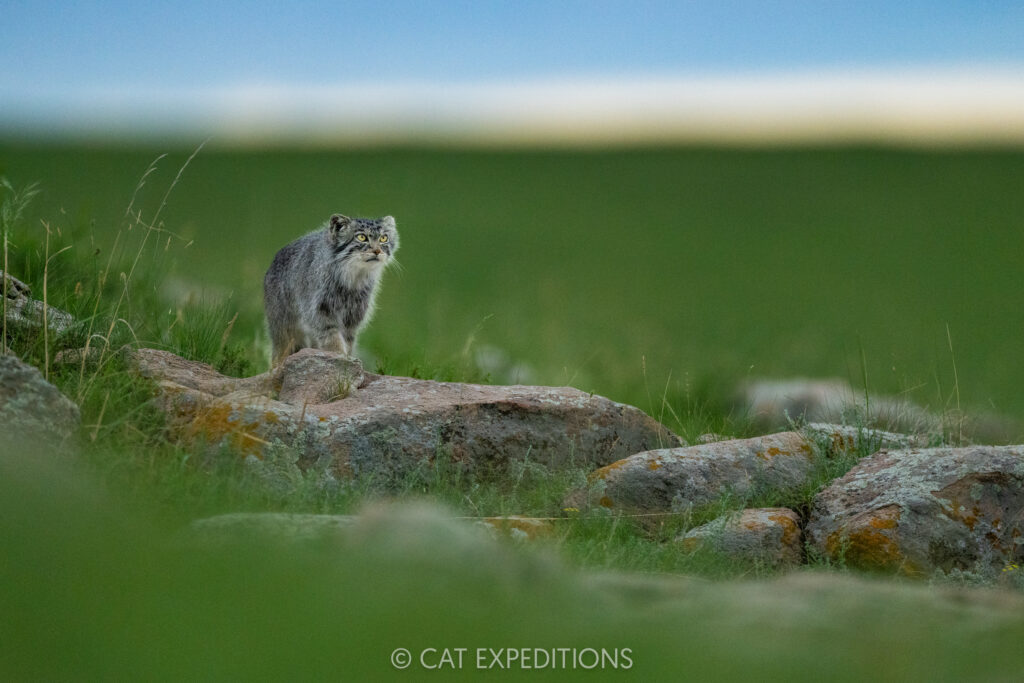
Her appearance was like the flip of a switch. As if given the green light, the kittens began to stir—stretching and groggily climbing out onto the rocks, blinking in the soft morning light. As the sun crested the hill behind us, gently warming the den, the kittens seemed to wake up completely… and then the fun began.
Two of Nutella’s kittens are usually the bold adventurers, with the third a bit more hesitant, hanging back and observing. But this morning? All three were fully charged. For two glorious hours they tumbled, wrestled, pounced, and bounded across the rocks. Ears and tails were prime targets. Grass tufts became imagined prey. At one point, a kitten launched into a somersault so clumsy and delightful it left us giggling behind our cameras. Watching manul kittens play is the kind of joy that just never gets old.
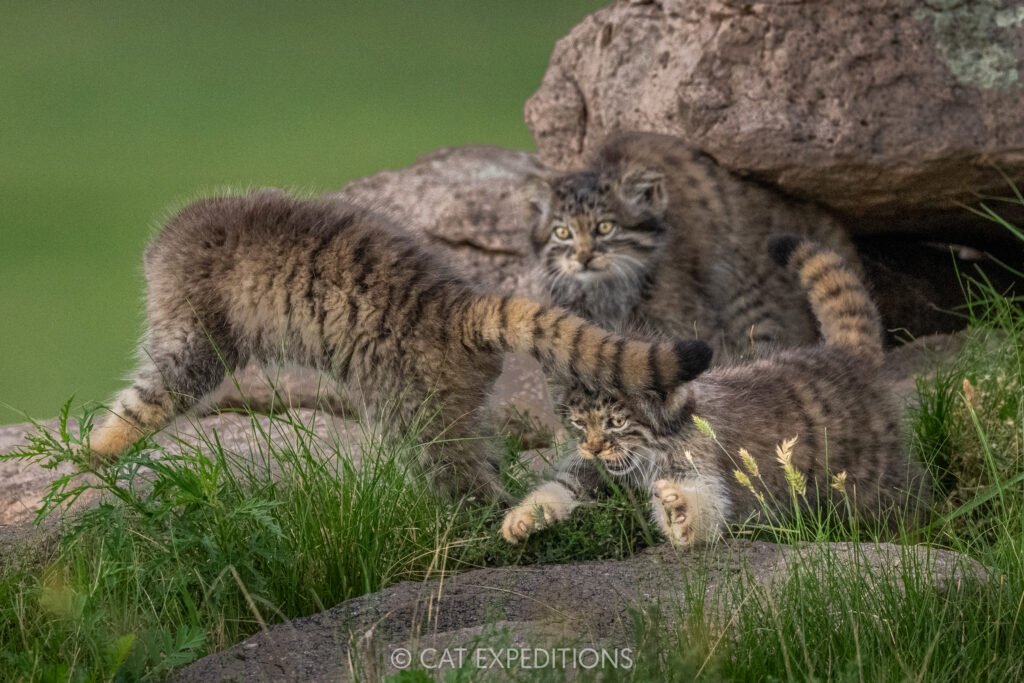
Now and then, one of the kittens would dash away from the den—always a sure sign Nutella had returned. We only ever caught brief glimpses of her, but we knew she was delivering breakfast. We’d hear the telltale growls and scuffles from within the rocks—tiny, fierce battles for ownership of a vole, always just out of sight.
Then, as if fueled by the meal, the kittens would burst back out, wilder than before. Some of the play got so rowdy we could actually hear the thump of little heads against rock during a tumble. But these are manuls—tough as the terrain they live in. No complaints, no hesitation. Just back to the chase, again and again.
It was one of those mornings that fills your tank as a photographer, as a wildlife lover, as a human. Pure joy, wild energy, and that deep sense of connection that keeps us coming back to these cats, day after day.
By now, we were in a rhythm—heading straight back to Nutella, our favorite feline queen. We couldn’t resist trying that particular blind position one last time. It hadn’t quite paid off in the afternoon, the day before, but we had a feeling it still held some magic.
At first, it felt like déjà vu: a fleeting glimpse of Nutella as she disappeared into the steppe on a hunting mission, and then… quiet. The kittens stayed tucked away in the cool shadows of the den, smartly avoiding the scorching afternoon heat. We waited, hopeful but sweaty, convincing ourselves that patience would pay off.
And it did. As the sun finally dipped behind a veil of clouds, Nutella returned. Moments later, the kittens poured out of the den, full of pent-up energy and mischief. The silence was replaced with the joyful chaos of play: pounces, tumbles, tail-chasing, and those wild kitten zoomies that never get old. It was a perfect payoff to a slow start, and a reminder that with wildlife, the magic often happens when you least expect it.
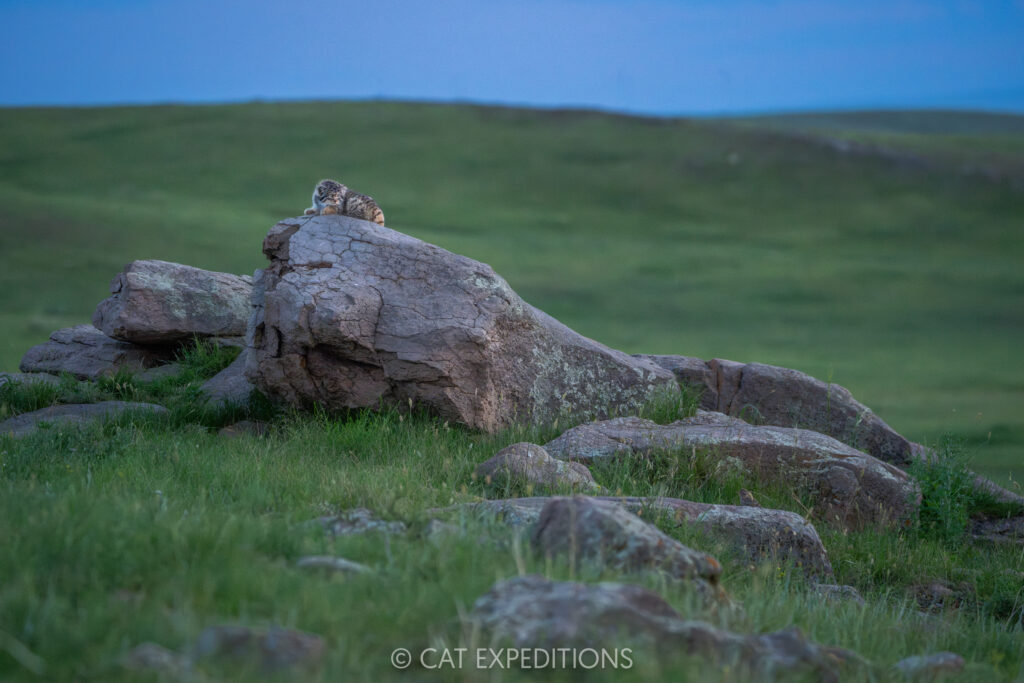
Day 6: Riding the high of two successful sessions from our previous blind position, we decided to get a little bold. This time, we shifted into a more unconventional angle—less forgiving than front-lit shots, but with the potential for something truly special: backlit magic. It was a bit of a gamble, but that’s the kind of creative risk we live for in wildlife photography.
As if on cue, the cats emerged not long after we settled in—yawning, stretching, and grooming their way into the day. And then the sky… oh, the sky. It transitioned from soft pinks to rich golden hues, casting the steppe in a dreamlike glow. The kittens clambered up their favorite rock perches, giving us the perfect silhouettes.
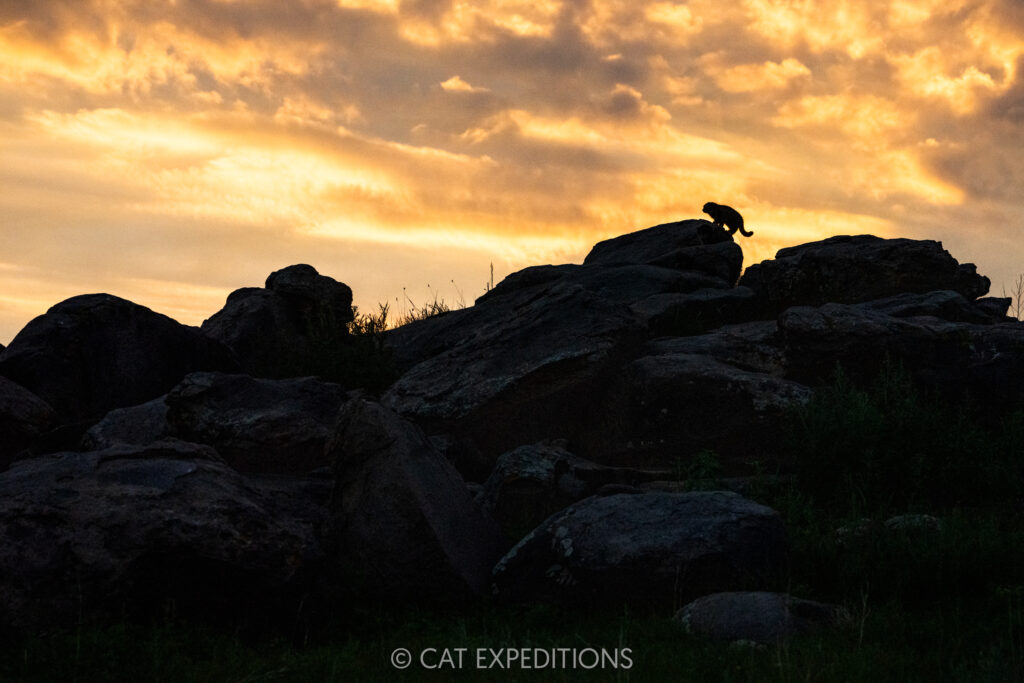
These kinds of colorful skies are rare at sunrise here in Mongolia, and to pair that with such perfect behavior from the manul family? It felt like everything aligned. We were absolutely buzzing—this was the kind of session that reminded us why we wake up at 3:30am and chase light across the wild steppe.
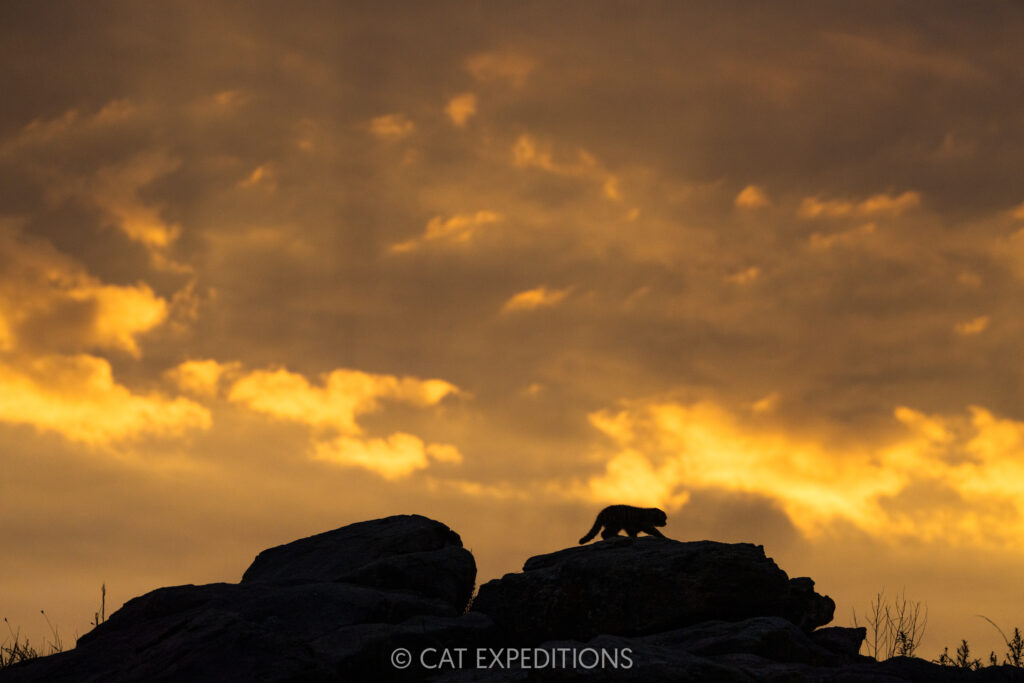
In the afternoon, we returned to the same blind position we’d used that morning, hopeful for some beautiful front-lit manul moments. But—as often happens with wildlife—the cats had a different plan. Nutella slipped out of the den so quietly and quickly that we almost missed her entirely. Meanwhile, the kittens—now officially named P, B, and J (yes, we fully committed to the spreadable theme!)—were mostly tucked away, clearly not fans of the lingering heat.
Every now and then, P—the boldest of the trio—would explode across the rocks in a blur of fur and confidence. It was incredible to witness… if only we could have actually photographed it! He pulled the same lightning-fast stunt five or six times, each more impossible to catch than the last. Eventually, we just laughed, appreciating the wild energy even if it left our cameras in the dust.
As the sun dipped behind the horizon, Nutella still hadn’t returned. She was clearly making the most of her evening hunt, and with the light gone, we packed up and made our way back to camp—grateful, entertained, and eager for what tomorrow might bring.
Day 7: Our final morning of manul photography had arrived, and to mark the occasion, we chose a brand-new spot for the blind—one last fresh perspective before wrapping up an unforgettable trip. Across our three annual manul tours, the average wait time for the cats to emerge is around 90 minutes. But with Nutella and her trio of kittens—P, B, and J—this trip had been exceptional. Their appearances were almost immediate. This morning was no different.
We had barely settled in before B, the second boldest of the bunch, was already darting across the rocks, full of energy and curiosity. A couple of Rock Sparrows landed on some stones between us and the den, and suddenly B locked in—his entire body switched to full hunting mode. Jerky bursts of movement, dramatic crouches, the intense stare… he began stalking straight toward us.
The sparrow, still clueless, stayed put as B crept closer and closer. At just six meters from our blind, the tension was sky-high. Was this about to be his first successful hunt? Alas, kitten instincts still had a lot to learn—he made his move right as the bird looked directly at him. Too soon. The sparrow launched into the air and vanished in a blur.

While no feathers flew, the moment was absolutely electric. Watching a young manul practice one of life’s most essential skills—right in front of us—was the perfect note to end on. A small step for B’s hunting journey, and a giant, unforgettable gift for all of us watching.
The rest of the morning the kittens spent doing their usual, mostly chasing each other. Their tails, ears, and backs. It never gets tiring!
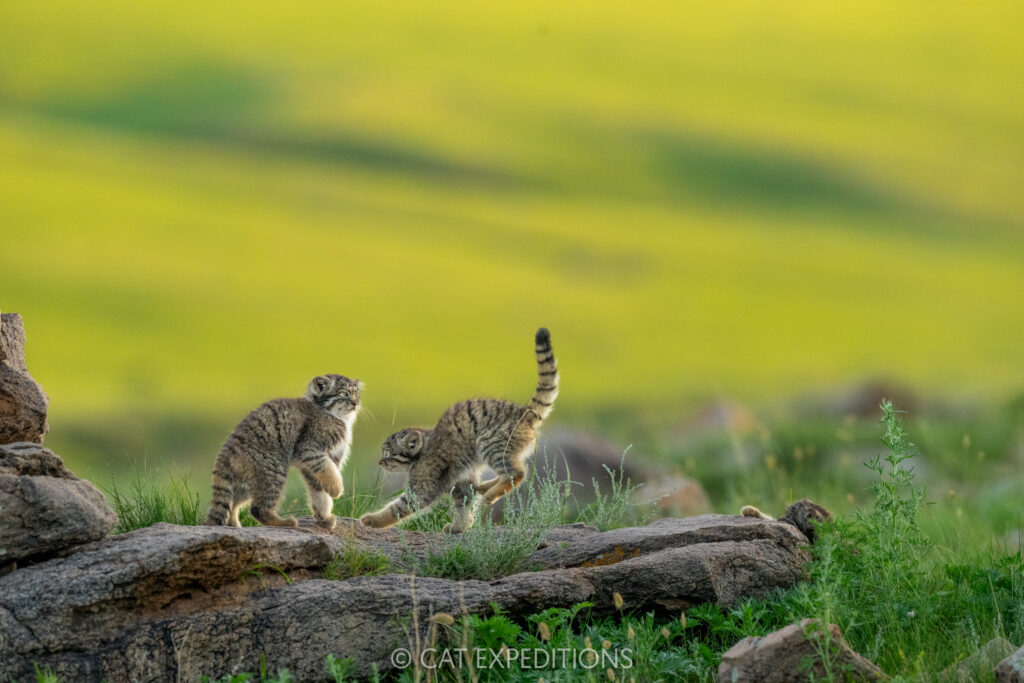
By late morning, the skies had fully opened, releasing a steady curtain of sprinkles that clung to everything—our gers, our gear, and our hopes for one final session with Nutella and her kittens. As lunch passed and the rain only thickened, a quiet nervous energy crept in. This was our last chance. Would the weather give us one more glimpse of the cats we’d grown to love so deeply?
By 5pm, our usual departure time, a light drizzle still hung in the air—but there was no question. We were going. Rain jackets zipped, towels draped over cameras, we made our way out, determined to say goodbye properly. And, true to form, Nutella and her crew delivered. Barely having settled into the blind, the kittens appeared, their dense coats shrugging off the water like pros. Mom stepped out for a hunting foray, totally unfazed by the weather, while her young ones bounced around the rocks for a quick play session.
But the rain had other plans. It thickened into fat, cold drops that soaked us through and eventually sent the kittens retreating into the den. We held out as long as we could—grateful, soggy, and silent—before finally calling it. As we drove back through the wet steppe, we didn’t feel defeated. Quite the opposite. We felt full—of moments, of stories, of gratitude—for getting one last rainy, wonderful goodbye with Nutella and her incredible little family.
Over the course of our three Manul of Mongolia tours, it was impossible not to fall head over heels for Nutella and her incredible little family. Watching P, B, and J grow from wide-eyed kittens—nervously peeking out from their den—to playful explorers boldly climbing rocks and chasing songbirds was an experience none of us will ever forget. It’s the kind of intimate wildlife journey that stays with you forever, and one we are proud to play a part in hosting for our guests.
Our biggest hope now? That each of these feisty kittens hones their hunting skills, sets off on their own, and finds a perfect patch of steppe to call home. As for us, we’ll be back next year, scanning the golden hills and rocky outcrops once again—hoping for a reunion with Nutella, and maybe even one of her now-grown kittens, thriving in the wild landscape they were born to.
Day 8: The rain carried on through the night, soaking the steppe and turning our route back to Ulaanbaatar into a slick, muddy adventure. One of our vehicles even threw in a 180-degree, semi-controlled spin—an unexpected burst of adrenaline that jostled everyone awake. A final photo stop for some cooperative upland buzzards gave us our last frames of the journey before rolling into the city, making surprisingly good time.
Back at the Kempinski, our first order of business was long, hot showers—rinsing off the layers of dust and grit that had become part of us over the last week. Memory cards and hard drives were bursting at the seams, full of unforgettable images of manuls and the magical steppe.
That night, during our final farewell dinner, the room was filled with laughter and warm retellings of favorite moments. Each guest shared something personal—a story, a sighting, a quiet feeling—that made the trip special to them. And woven through each story was the manul, the little steppe cat that brought us all together. We left that table not just as travelers, but as a group forever connected by a week of wild beauty, shared patience, and the magic of Mongolia.
Manul of Mongolia Photo Tour 2025 Species List – Trip 3
Mammals
| Manul | Otocolobus manul |
| Corsac Fox | Vulpes corsac |
| Tarbagan Marmot | Marmota sibirica |
| Long-eared Jerboa | Euchoreutes naso |
| Brandt’s Vole | Lasiopodomys brandtiie |
| Mongolian Gerbil | Meriones unguiculatus |
Birds
| Ruddy Shelduck | Tadorna ferruginea |
| Demoiselle Crane | Anthropoides virgo |
| Cinereous Vulture | Aegypius monachus |
| Steppe Eagle | Aquila nipalensis |
| Black Kite | Milvas migrans |
| Upland Buzzard | Buteo hemilasius |
| Eurasian Eagle-Owl | Bubo bubo |
| Saker Falcon | Falco cherrug |
| Peregrine Falcon | Falco peregrinus |
| Common Swift | Apus apus |
| Pacific Swift | Apus pacificus |
| Eurasian Hoopoe | Upupa epops |
| Daurian Jackdaw | Corvus dauuircus |
| Northern Wheatear | Oenanthe oenanthe |
| Isabelline Wheatear | Oenanthe isabellina |
| Horned Lark | Eremophila alpestris |
| Mongolian Lark | Melanocorypha mongolica |
| House Sparrow | Passer domesticus |
| Eurasian Tree Sparrow | Passer montanus |
| Rock Sparrow | Petronia petronia |
